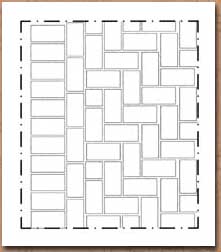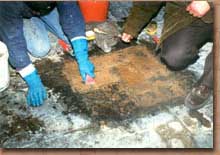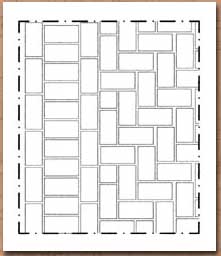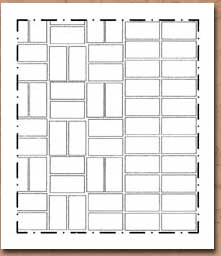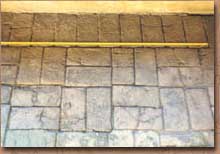Results of the cloister pavement analysis
edited by di Mara Falconi
The ground floor corridors of the cloister are paved in various forms of brickwork, whose diverse periods of execution can be distinguished. The original pavement probably dates back to the early years of the 17th century. This first pavement can above all be traced in the west and north corridors and has a fascia e bindello design along each side to mark their perimeter with an internal herring-bone pattern (fig. 1) interrupted by a band of bricks laid on edge at the point where the corridors meet. The bricks vary in dimension from 13 x 25.6 cm to 13.5 x 26.8 cm with a joint that also varies between 1.3 and 2.8 cm. The whole pavement has been damaged by a series of restoration treatments and subsequent substitutions that have altered its original appearance; these can mostly be traced back to two separate historical events. The first substitutions can probably be attributed to the 18th century. The bricks are slightly larger varying between 14 x 27-30 cm and their composition is different from the original ones; the color tending more towards pink. In certain areas, above all in the north corridor where there is a greater amount of original paving, an attempt was made to respect the design and match its pattern, by trying to adapt bricks of different sizes to the lacunae. In the other corridors, instead, the same type of brick has been inserted in the most haphazard way, ignoring the original pattern and even cutting the existing bricks in order to insert new ones. The most recent reintegration, during Antonio Muñoz's restoration work, completely fails to respect the lines of the former pattern, also due to the larger size of the bricks, which are 15 x approximately 30 cm and of a rather coarse-grained industrial manufacture.There is only one case during the twentieth century restoration work where recovered bricks were used to reintegrate the lacunae left by the demolition of a partition wall in the north corridor. The whole pavement is in a fairly advanced state of deterioration caused above all by the marked presence of humidity due both to capillary attraction and to the considerable quantity of salts and nitrates that have accumulated within the stone material. The latter phenomenon has been aggravated by the fact, arising from the tests carried out, that the bedding layer is in direct contact with the soil. Furthermore, the entire surface is covered by a thick layer made up of oxidised and stratified lichens, solidified fats of various nature and cement. The cement is the one that poses greater problems both of an aesthetic nature and with regard to deterioration, given its presence over a fairly extensive area, above all in the south corridor and at the southern part of the east corridor. All the joints of the entire pavement have been made with cement which, attached as it is to the surface layer, impedes surface evaporation further aggravating the problems of humidity stagnation. The preliminary tests carried out (fig. 2) have shown that the poultices applied have only removed strata and deposits of a different nature. In order to eliminate the cement, it is necessary to resort to mechanical removal of a particularly delicate nature to avoid the risk of also detaching the surface layer of the brick. This fact, together with the test results, indicate that the treatment to be carried out to restore the pavement will have to vary according to the state of the surface in the different areas, and above all, will have to guarantee an aesthetically pleasing result that blends in with the context (fig. 3).Apart from its historical and documentary value, the pavement forms an integral part of the whole ambience and contributes significantly to the image of the site, also as a result of the wear and tear and transformations it has undergone over the years. For these reasons the possibility of removing it has been excluded in favor of recovery treatment and surface protection which, though presenting greater problems, makes it possible to conserve the overall effect of its established image without altering it. The bricks that presently have disintegrated or become fragmented, will be consolidated with a specially prepared mortar that is compatible with the characteristics of the original stone material.
As far as the pavements of the first floor gallery are concerned, they are even more varied than those on the ground floor.They are of a later date than the 17th century in that they cover an earlier pavement of worn mashed brick that relates to the transformations that the cloister underwent during the addition of the upper floor and the construction of the vaults. The sizes vary from 26 x 13 cm to 29 x 14 cm and the bricklaying is also quite varied. The following types of brickwork are evident: fascia e doppio bindello with herring-bone in the center (fig. 4); herring-bone in the center which is interrupted by the parapet with a simple fascia along the wall; double fascia on one side and single fascia on the other with a canestro pattern in the center (figg. 5, 6). Within these three different design types, there are a series of varied restoration treatments that are completely alien to the design scheme into which they have been inserted. They have furthermore been carried out with bricks that are so totally different to the pre-existing ones that they have not only altered the structure of the whole pavement but also its chromatic effect. The entire pavement has lost its surface layer and cracks and fracturing are evident in correspondence to the keystones of the underlying vaults. The east wing of the gallery has been filled in and its interior has been adapted for monastic use. The original pavement has consequently been replaced by a modern one in green that shows no signs of deterioration but appears unsuitable for its context.
© 1999 Coordination
Monica Morbidelli
© 1999 Altair 4 Multimedia
© 1999 All the material on this site is under the copyright of the Augustinian
Community of the
the Monastery of Ss. Quattro Coronati
Webmaster: techaltair@altair4.it
|
Fig. 1 - Paving plan of the original brick pavement of the ground floor corridors of the cloister: fascia e bindello at the side and herring-bone in the center.
Fig. 2 - Pavement of north ground floor corridor of cloister.
Fig. 3 - Cleaning test carried out in north ground floor corridor of cloister.
Fig. 4 - Example of card recording preliminary cleaning tests.Example of card recording preliminary cleaning tests.
Fig. 5 - Paving plan of the brick pavement of the south corridor situated on the upper floor of the cloister: fascia con doppio bindello at the side and herring-bone in the center.
Fig. 6 - Paving plan of the brick pavement of the north side of the north gallery situated on the upper floor of the cloister: doppia fascia above and canestro at the center. |
|
|
|
|
|
|
|
|
|
|
|
|
|
|
